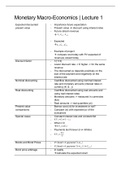Class notes
Full Lecture Notes for Monetary Macroeconomics
- Course
- Institution
These documents contain full lecture notes on Monetary Macroeconomics, complete with graphs. The notes highlight the points that you need to know for the finale exam.
[Show more]



